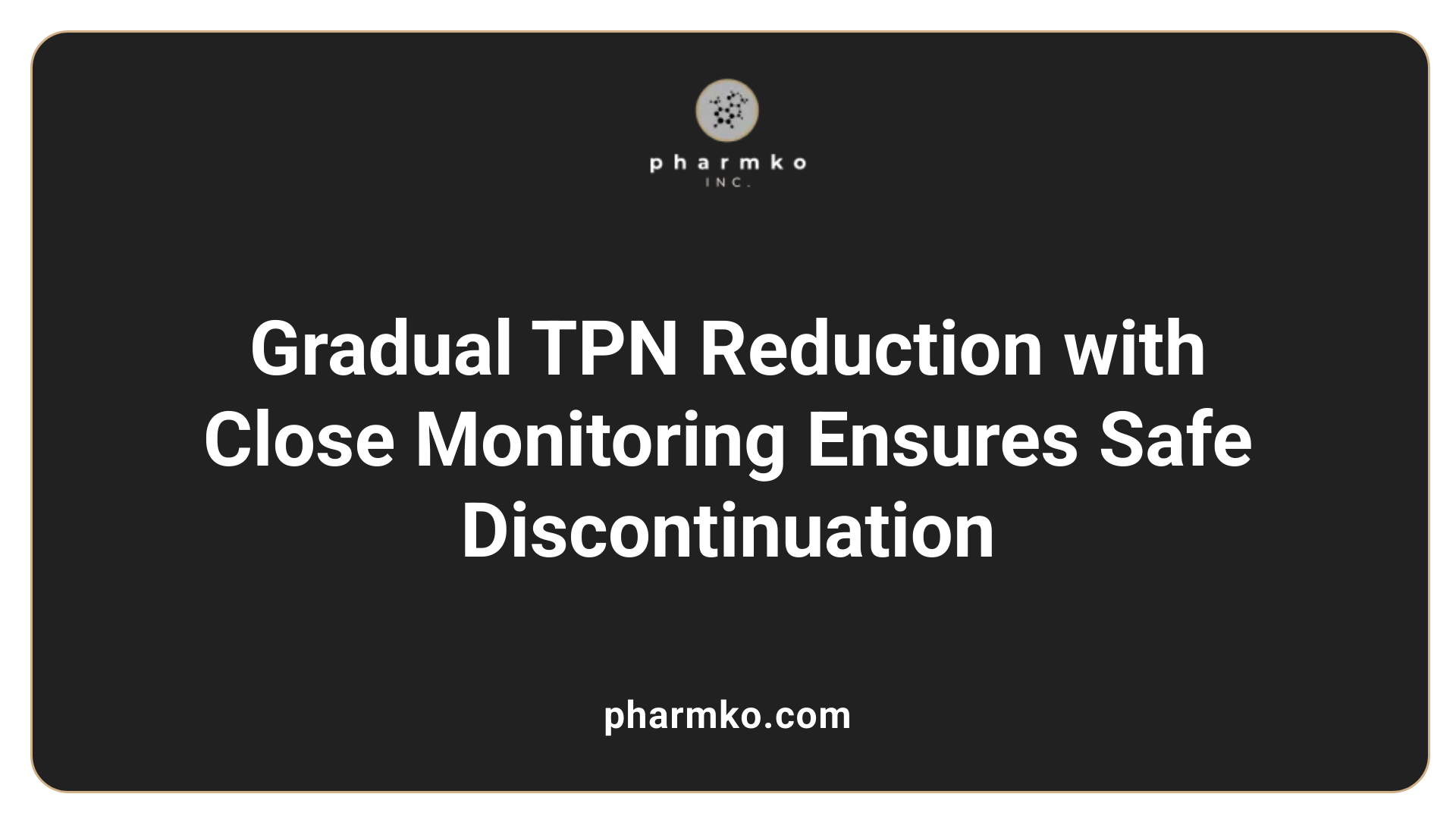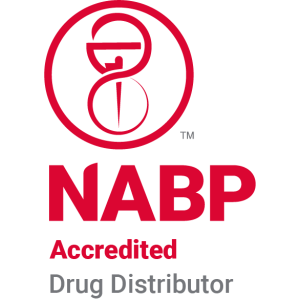Transitioning from TPN to Oral or Enteral Nutrition
Understanding the Shift from Parenteral to Enteral and Oral Nutrition
Transitioning from total parenteral nutrition (TPN) to oral or enteral feeding is a critical step in patient recovery, requiring careful planning, assessment, and multidisciplinary collaboration. This article explores the scientific guidelines, clinical procedures, and best practices that underpin a safe and effective transition, aiming to optimize patient outcomes and nutritional adequacy.
Structured Approach to Transitioning from TPN

What are the guidelines for transitioning from TPN to oral or enteral nutrition?
The process of moving from Total Parenteral Nutrition (TPN) to oral or enteral feeding must be undertaken carefully and systematically. The standard procedure is to gradually reduce TPN over a period of 48 to 72 hours, allowing the gastrointestinal system time to adapt and assuming the patient shows signs of adequate tolerance.
A key goal during this transition is to ensure that enteral nutrition provides between 60% and 75% of the patient's total caloric and protein requirements. This amount can be adjusted based on ongoing assessments of the patient’s nutritional needs and clinical stability.
Healthcare teams typically initiate the transition once the patient demonstrates gastrointestinal readiness, such as the ability to tolerate the introduction of oral or enteral feeds, adequate bowel movements, and stable weight. The process involves a stepwise reduction in the volume of TPN while incrementally increasing enteral feeds. During this period, close monitoring for any signs of intolerance—such as increased gastric residuals, abdominal distension, diarrhea, vomiting, or aspiration—is essential.
Monitoring also includes tracking laboratory parameters, electrolyte balance, hydration status, and overall clinical indicators. If intolerance or complications arise, the transition may need to be slowed or temporarily halted.
The primary aim is to ensure continuous nutritional support that meets the patient's needs without overwhelming the digestive tract. Once the patient consistently tolerates enteral nutrition at the targeted levels, and meets 60-75% of their caloric and protein requirements through these feeds, TPN can be safely discontinued.
This gradual approach minimizes risks associated with abrupt changes, such as refeeding syndrome or malnutrition, and promotes gastrointestinal recovery and functional improvement.
In summary, the guidelines recommend a structured, closely monitored process that emphasizes patient safety, nutritional adequacy, and tolerance, with regular clinical assessments and adjustments as needed.
Protocols for Discontinuing TPN Safely

What protocols exist for discontinuing TPN?
Discontinuing total parenteral nutrition (TPN) is a critical step in patient recovery and requires careful planning to avoid complications. The general consensus among healthcare providers emphasizes a gradual reduction, or tapering, of TPN to smoothly transition the patient to enteral or oral feeding.
For long-term TPN use, protocols recommend slowly decreasing the infusion rate over several days. This gradual approach helps prevent hypoglycemia—a common concern when glucose supply is abruptly cut—and reduces the risk of metabolic disturbances.
In neonatal patients, specific guidelines suggest stopping TPN once enteral nutrition (EN) reaches about 140-150 ml/kg/day. The timing depends on individual clinical status, gastrointestinal function, and tolerance to enteral feeds.
In adult and pediatric populations, clinicians typically monitor various metabolic parameters—including blood glucose, electrolytes, liver enzymes, and acid-base status—during the weaning process. As the patient's tolerance improves, TPN is tapered in tandem with increasing enteral intake.
Although standardized, one-size-fits-all protocols are rare, most recommendations highlight an individualized approach. This involves assessing patient stability, nutritional requirements, and the ability to maintain adequate nutrition orally or enterally.
Throughout this process, clinical judgment and careful monitoring are vital. Signs of intolerance—such as hypoglycemia, electrolyte imbalance, or nutritional deficits—must be swiftly addressed. The overarching goal is to transition safely while maintaining optimal nutritional status.
In summary, TPN discontinuation protocols prioritize a cautious, stepwise reduction of infusion rate paired with close observation of metabolic parameters. Such approaches ensure smooth transition and minimize risks associated with abrupt cessation.
| Aspect | Typical Approach | Considerations |
|---|---|---|
| Weaning Strategy | Gradual reduction over days | Monitoring for hypoglycemia, electrolyte stability |
| Metabolic Monitoring | Regular checks of blood glucose, electrolytes, liver function, acid-base balance | Detecting early signs of imbalance |
| Entry Criteria for Discontinuation | Adequate enteral/oral intake reaching 50-75% of requirements, clinical stability | Ensuring nutritional adequacy post-TPN removal |
| Neonatal Specifics | Tapering when EN reaches ~140-150 ml/kg/day | Based on individual tolerance |
This approach underscores the importance of careful, individualized planning in the safe discontinuation of TPN, aiming to sustain nutritional needs while minimizing risks.
Comparison of TPN and Enteral Nutrition in Clinical Practice

How does TPN compare to enteral nutrition in terms of effectiveness and indications?
Total parenteral nutrition (TPN) and enteral nutrition (EN) are two distinct methods of providing nutritional support in clinical settings, each suited to different patient conditions. EN, often called tube feeding, involves delivering nutrients directly to the stomach or small intestine via a feeding tube. It is generally the preferred initial approach when the gastrointestinal (GI) tract is functioning properly.
The effectiveness of EN lies in its ability to maintain gut integrity, stimulate the immune response, and support the gut microbiome. It also minimizes risks associated with intravenous access, such as line infections. EN typically supports better overall clinical outcomes, including fewer infections — such as pneumonia and bacteremia — and shorter hospital stays.
On the other hand, TPN involves infusing a nutrient mixture directly into the bloodstream through a central or peripheral vein. It is indicated when the GI tract is non-functional or when enteral feeding cannot meet nutritional needs—examples include severe malabsorption, bowel obstructions, or significant gastrointestinal trauma.
While TPN is crucial in certain scenarios, it presents higher risks compared to EN. These include infections from central lines, metabolic disturbances like hyperglycemia or electrolyte imbalances, and liver complications such as cholestasis and fibrosis. Because of these risks, TPN is usually reserved for patients who cannot receive or tolerate enteral feeding.
Multiple clinical guidelines and research studies consistently favor early initiation of EN owing to its safety, cost-effectiveness, and positive impact on patient recovery. However, in cases where EN is contraindicated or insufficient, TPN provides an essential alternative to meet nutritional demands.
Impact on gut health and infection risk
Enabling the gut to process nutrients helps preserve its structure and function, preventing atrophy and supporting the microbiome diversity crucial for immune health.
Conversely, reliance solely on TPN without gut stimulation can lead to mucosal atrophy, loss of gut microbiota diversity, and bile acid circulation issues. These changes might increase the risk of infections and liver complications.
Infection risks are notably higher with TPN due to the necessity of invasive central intravenous access. The risk of bloodstream infections and line-related complications has been well-documented, emphasizing the importance of strict aseptic procedures.
The decision to use TPN or EN depends on a combination of patient-specific factors—including the condition of the GI tract, nutritional requirements, and risk profile—and ongoing clinical assessments.
| Aspect | Enteral Nutrition | Parenteral Nutrition | Additional Details |
|---|---|---|---|
| Effectiveness | Supports gut integrity and immune function | Bypasses GI, directly meets nutritional needs | Guides clinical choice based on gut function |
| Indications | Functional GI tract but unable to eat | Non-functional GI tract or contraindications to EN | Critical for malabsorption, bowel surgery |
| Safety | Fewer complications, supports microbiome | Higher infection and metabolic risk | Requires careful management and monitoring |
| Impact on gut health | Preserves mucosal integrity | Risk of atrophy and microbiome loss | Important for long-term outcomes |
| Infection risk | Lower | Higher, due to IV line use | Emphasizes aseptic techniques |
This comparison highlights the importance of tailored nutritional strategies based on individual patient profiles to optimize recovery and minimize complications.
Clinical Considerations and Patient Assessment

What is the typical process and clinical considerations involved in transitioning from TPN to oral or enteral nutrition?
Transitioning from Total Parenteral Nutrition (TPN) to oral or enteral nutrition requires a structured, patient-specific approach carried out over approximately 48 to 72 hours. Healthcare professionals begin by assessing the patient's current nutritional and clinical status, including their gastrointestinal (GI) functionality, stability, and tolerance to oral or enteral feeding.
The process involves gradually increasing the amount of enteral nutrition (EN) while decreasing TPN, ensuring that caloric and protein requirements are met without overwhelming the GI system. During this period, clinicians carefully monitor for signs of intolerance such as increased gastric residual volume, bloating, diarrhea, vomiting, or abdominal distension.
Patients typically need to reach a point where they can tolerate at least 60-75% of their prescribed caloric and protein needs through EN before discontinuing TPN completely. This margin helps prevent nutritional deficits and supports gut integrity. The transition also aims to prevent complications like refeeding syndrome, which can occur if nutrition is reintroduced too rapidly.
Throughout this process, multidisciplinary teams—including physicians, dietitians, and nursing staff—collaborate to ensure safe progression. They utilize clinical judgment, assessment tools, and frequent monitoring to tailor the transition plan, ensuring it aligns with the patient's individual stability, nutrition needs, and tolerance levels.
How can clinicians assess a patient's readiness for nutritional transition?
Assessing a patient's readiness involves comprehensive evaluation of their nutritional, physical, and psychological status. Clinicians often use standardized assessment tools such as the Transition Readiness Assessment Questionnaire (TRAQ), which helps measure confidence, knowledge, and preparedness as reported by both patients and caregivers.
Beyond tools, clinicians measure physical parameters like weight stability, body mass index (BMI), serum vitamin and mineral levels, and other laboratory markers to determine nutritional adequacy. Evaluating gastrointestinal (GI) function through assessment of bowel sounds, residual volumes, and the absence of significant nausea or vomiting is crucial.
Medical history is reviewed for factors that may influence readiness, such as ongoing infections, metabolic disturbances, or comorbidities. Psychological readiness and emotional maturity are also considered, ensuring the patient and family are prepared for self-feeding.
The care team engages the patient in shared decision-making, setting realistic goals tailored to individual circumstances. Gradual introduction of enteral feeds, starting from clear liquids progressing to more complex formulas, provides opportunities to evaluate tolerance.
Continuous monitoring of clinical signs—including weight, intake/output, laboratory tests, and gastrointestinal tolerance—guides ongoing adjustments. This dynamic assessment helps identify any issues early and supports a safe, effective transition from TPN to self-managed feeding.
Best Practices and Multidisciplinary Management

How do healthcare teams contribute to the transition from TPN to oral or enteral nutrition?
Managing the shift from parenteral nutrition (PN) to enteral or oral feeding is a complex process that benefits greatly from a team-based approach. Multidisciplinary teams, often referred to as Nutrition Support Teams (NSTs), are essential for developing and implementing effective transition plans. These teams typically consist of healthcare professionals such as dietitians, nurses, physicians, and sometimes pharmacists or speech-language pathologists.
Their collaborative efforts focus on providing comprehensive nutritional assessments, planning individualized transition strategies, and ensuring safe administration of nutrients during the process. By monitoring patients closely, they help prevent complications like aspiration, refeeding syndrome, or nutritional deficits. These teams also coordinate education for patients and caregivers, lay out protocols for gradual weaning, and regularly evaluate progress through clinical and laboratory data.
Such coordinated care not only promotes safety and efficacy but also aligns with established guidelines, reducing the risk of hospital readmissions and improving patient outcomes.
What are best practices for safely weaning a patient off TPN?
A safe and effective transition off TPN requires careful planning and monitoring. First, clinicians must assess the patient’s gastrointestinal function, ensuring that the gut is capable of tolerating enteral or oral intake. This involves evaluating gastrointestinal motility, residuals, and the presence of symptoms such as nausea or distension.
The weaning process should be gradual, typically reducing TPN calories stepwise while increasing enteral or oral intake. This approach prevents metabolic disturbances, refeeding syndrome, and other complications. Regular monitoring includes tracking weight, electrolyte levels, blood glucose, and gastrointestinal tolerance. Adjustments are made based on clinical responses.
Addressing symptoms like nausea or diarrhea swiftly can facilitate smoother transition. Involving a multidisciplinary team ensures that nutritional plans are tailored to the patient’s needs, preferences, and medical condition, optimizing safety during the weaning process.
What factors influence the success of a nutrition transition?
The success of transitioning from TPN to enteral or oral intake depends on several factors. Clinical stability, gastrointestinal readiness, and nutritional status are primary. Patients with preserved gut function, minimal active infections, and stable metabolic control are more likely to tolerate transition.
Age, presence of inflammation, and underlying conditions such as metastatic cancer may impact appetite and the ability to establish adequate oral intake. Conversely, hunger often correlates with a greater likelihood of successful transition, as observed in some clinical studies.
Additional considerations include the patient’s psychological readiness, social support, and adherence to the nutrition plan. Regular assessment and individualized care plans are essential for addressing these variables.
How is monitoring integrated into the transition process?
Monitoring is integral to ensuring successful and safe nutrition transition. Key areas include:
- Gastrointestinal tolerance: Watch for symptoms like distension, diarrhea, vomiting, or gastric residuals.
- Nutritional adequacy: Track caloric and protein intake compared to prescribed needs.
- Laboratory tests: Regularly check electrolytes, blood glucose, liver function tests, and other pertinent labs.
- Weight and physical status: Monitor weight changes and muscular mass for signs of malnutrition or overfeeding.
- Complication signs: Be vigilant for infections related to catheter use, aspiration risks, or metabolic disturbances.
This ongoing assessment guides adjustments in the nutrition plan, ensures timely intervention when issues arise, and supports a smooth transition from PN to enteral/oral feeding.
How do multidisciplinary teams implement structured care during transition?
Implementation begins with developing protocols rooted in clinical guidelines and best practices. Healthcare teams conduct comprehensive patient assessments, including nutritional, medical, and psychosocial parameters. They establish stepwise plans to introduce oral or enteral feeds, starting with low residue diets or clear liquids.
Education and training for staff, patients, and families are vital to foster understanding and adherence. The team closely monitors tolerance and makes real-time modifications as necessary.
Periodic reviews, audits, and data collection help refine practices and promote continuous improvement. Effective communication within the team ensures that all members are informed, coordinated, and proactive in managing potential complications.
Summarized overview of patient management during the transition
| Aspect | Practice | Description |
|---|---|---|
| Assessment | Evaluate GI function, nutritional status, and readiness | Essential before initiating transition |
| Gradual reduction | Taper TPN while increasing enteral/oral intake | Prevents metabolic disturbances |
| Monitoring | Regular labs, weight, tolerance evaluation | Ensures safety and progress |
| Team collaboration | Multidisciplinary planning and review | Facilitates individualized, safe transition |
| Emergency preparedness | Protocols for complications like aspiration or refeeding syndrome | Quick response minimizes adverse outcomes |
By implementing these practices, healthcare providers can optimize the transition process, balancing nutritional needs with patient safety.
Summary and Future Directions in Nutritional Transition
The shift from TPN to oral or enteral nutrition is a nuanced process that hinges on careful patient assessment, structured protocols, and coordinated multidisciplinary efforts. Emphasizing gradual progression, vigilant monitoring, and individualized strategies helps mitigate complications and promotes nutritional recovery. As research advances, developing standardized guidelines and leveraging innovative assessment tools will further enhance safety and efficacy in nutritional transition, ultimately improving patient outcomes across diverse clinical settings.
References
- Transition from total parenteral nutrition to enteral ...
- The transition from PN to EN
- Hunger and the transition from parenteral nutrition in ...
- Parenteral Nutrition: What it Is, Uses & Types
- Nutrition Support and Transition of Care Series Part 1
- The Process of Transitioning to Oral Feeding
- Transitioning to oral feeding: A retrospective cohort study of a ...
- oral nutrition support, enteral tube feeding and parenteral ...
- The Hitchhiker's Guide to Parenteral Nutrition Management ...
- Nutrition Support (Enteral and Parenteral)













